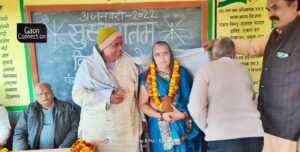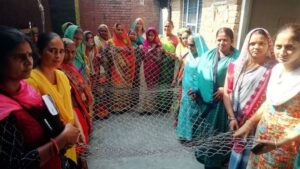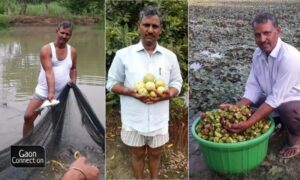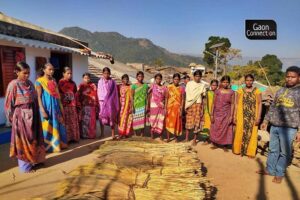Armed with a compact box loaded with COVID19 vaccines, Lalta Kumari, an auxiliary nurse midwife (ANM) and a frontline health worker, is leading the fight against the coronavirus in flood-affected villages of Bihar.
While the majority of the frontline workers walk, trek or travel by road to vaccinate the rural population, Lalta has been moving around in a boat, locally known as dengi.
Bihar is facing massive floods and parts of at least 14 districts of its total 38 districts, including Muzaffarpur, are inundated with hundreds of thousands villages marooned. And with the threat of the third wave looming large, people need to be vaccinated on a war footing. And who knows it better than Lalta who, for the past couple of days, is actively engaged in reaching out to marooned villagers in flood-ravaged Muzaffarpur district to inoculate them.
Known as Tika Wali Naav (COVID vaccination boat), two dedicated boats have been put to work in the district as part of the COVID vaccination campaign. Each boat has two ANMs, one data collector or verifier, a boat-person and a diver.
This novel initiative, which was kicked off four days back on July 9, is the brainchild of District Magistrate Pranav Kumar.
“The major concern was to vaccinate people who live near river embankments. They stay together in close proximity. This could increase chances of covid outbreak. We want to vaccinate them as soon as possible. That is how we came up with this idea of tika wali nav,” the district magistrate told Gaon Connection.
Frontline workers lead from the front
Thirty-six-year-old Lalta Kumari’s day starts early. “At eight in the morning, we report to the PHC [primary health centre]. From there, an ambulance drops us to the boat and then we go to the flood affected villages,” the ANM, who works in a sub health centre in Muzaffarpur district, told Gaon Connection.
As part of the vaccination drive, Tika Wali Naav keeps moving from village to village to vaccinate the people. Yesterday, on July 12, it reached Bhawanipur village near the Bagmati river, which is in full spate due to heavy monsoon rainfall in Bihar.
Also Read: ‘We’re ready to die but won’t let an embankment be built on the Bagmati’
Vaccinating people in a boat by maneuvering floodwaters isn’t easy. However, that hasn’t stopped health workers such as Lalta from carrying out the arduous task in the pandemic.
“Today [July 12] is my second day on duty on tika naav. I have vaccinated around sawa sau (125) people in a day. We are trying to vaccinate as many people as we can,” Lalta said.
Tika naav daily vaccinating 100-200 villagers
Everyday between 10 am and 3 pm, these health workers vaccinate 100-200 people on an average. On the first day of the vaccination campaign on July 9, only 20 people could be vaccinated. The next day, health workers managed to vaccinate 50 people. And slowly this number has reached 100-200 villagers a day.
As per the district authorities, so far, till July 12, over 500 people in flood-affected hamlets of Muzaffarpur have been vaccinated using the services of Tika Wali Naav.
Meanwhile, a total of 827,473 vaccination doses have been administered in the district so far. As per the 2011 census, there are around 4.8 million people in the district.
“We have five panchayats which are totally affected by floods. Villagers are unable to come to vaccination centres. We are trying to approach them using these boats,” District Magistrate Kumar said.
“Two dedicated boats are already in use. Meanwhile, the district has arranged for three more such boats so that one boat each is deployed for vaccination in each of the flood-affected panchayats,” he added.
Joining forces
The Tika Wali Naav initiative has been started with the joint effort of the district administration, the state health department, and CARE India, a not-for-profit working on projects in health, education, livelihoods and disaster preparedness and response.
As per the local people, Katra and Aurai blocks of Muzaffarpur district are badly affected due to floods. These areas get flooded every year due to Bagmati and Burhi Gandak rivers, which are the tributaries of Ganga.
Of all the blocks in Muzaffarpur, Katara block is the most affected by the floods, informed villagers. This has added to the vaccination challenges in the state.
“Katara block has twenty six panchayats. Of these, fourteen panchayats get cut off from the rest of the twelve panchayats by the flood waters. Obviously, people cannot swim in the flood river to get inoculated. Hence, we started this initiative,” Sourabh Tiwari, team lead of CARE India, told Gaon Connection. “Besides, we could not use steamers to reach small hamlets, we could only use boats in areas where people are trapped,” he added.
CARE India is providing technical assistance to verifiers going along with ANMs on boats.
“To avoid overwork of health workers and others, they are asked to report to work on a rotation basis,” said Tiwari. “In sixteen panchayats of Katara, there are around one lakh forty thousand (140,000) people. We have a target of vaccinating at least 100 people in a day. We will also start this initiative in other affected areas soon,” he informed.
Jeevika didis ensure community participation
Community participation has also played a key role in the ongoing COVID19 vaccination drive in the flood-affected district. Self-help group women, commonly known as Jeevika Didis under the National Rural Livelihood Mission, are assisting at the grassroots level for vaccination.
“Jeevika Didis are ensuring mass scale awareness on COVID vaccination. Involvement of Jeevika members ensures vaccination and mobilisation in a systematic manner at the grassroots level,” Anisha, district programme manager, Jeevika Muzaffarpur told Gaon Connection. By recording data, they keep a tab on the number of people vaccinated in a village and how many left, she said.
“In one federation of SHG, commonly known as a village organisation, there are around thirty SHGs. In every SHG there are at least ten to fifteen women members,” informed Anisha. If we take their help, we would be able to cover nearly seventy per cent of the population of the district, she added.
Apart from managing a smooth vaccination drive at the grassroots, these women are also beneficiaries of the vaccination campaign.
“Running a vaccination campaign in these villages is no easy task, people are hesitant to get inoculated. There are higher chances of agitation,” said Tiwari of CARE India. “These Jeevika Didis pre inform people about vaccination. They motivate people and make arrangements at ground zero so that the team does not face any inconvenience,” he added.
Incentives for ANMs?
Whereas the frontline health workers have taken on the additional duties of vaccinating people through tika naav, they complain they are not compensated properly for their work. No additional incentives have been provided to them. “Verifiers and ANMs being salaried workers are not provided separate incentives as of now,” informed Tiwari from CARE India.
Other than a monthly salary of Rs 25,500, Lalta Kumari said that she was not getting any incentives for the particular task. However, the boatmen and divers are being provided a daily incentive of at least Rs 200-Rs 300 each, said Tiwari.
On being questioned, the district magistrate assured Gaon Connection a decision to provide incentive to ANMs would soon be taken. “It is a tough terrain where these people are going for vaccination. We will recognise their contribution and give them incentives,” said Kumar.
Meanwhile, it is another morning and the dengi, the Tika Wali Naav, is set to travel to the next flood-affected village in Muzaffarpur to inoculate the rural people.



















